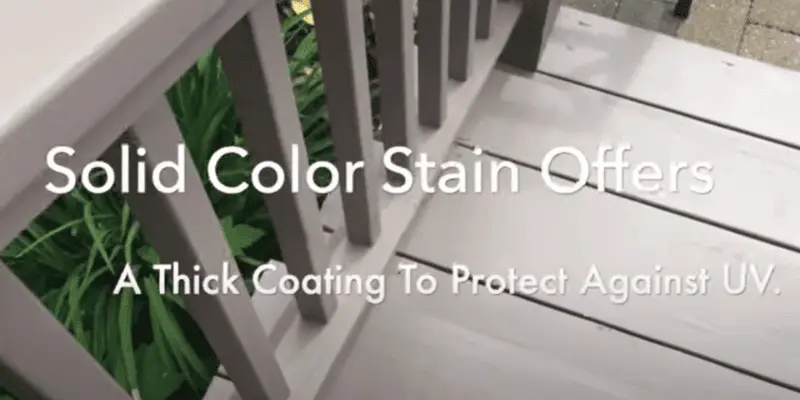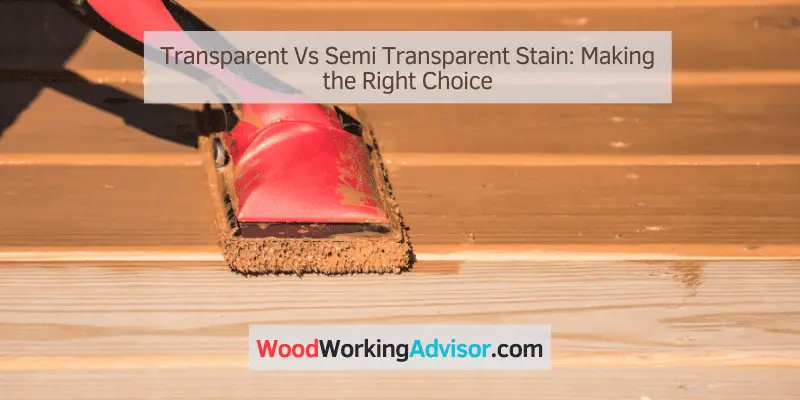Choosing between a transparent and semi-transparent stain largely depends on the level of opacity you desire for the wood surface. Transparent stain allows the natural grain of the wood to show through, while semi-transparent stain provides more color coverage with a hint of wood grain visibility.
When it comes to selecting the right stain for your project, understanding the differences between the two options will help you achieve the desired aesthetic and protection for your wood surfaces. Whether you are aiming for a more vibrant color or seeking to maintain the natural beauty of the wood, making an informed decision will ensure a satisfactory outcome for your staining project.
Understanding Transparent Stains
What Are Transparent Stains?
Transparent stains are a type of wood stain that allows the natural beauty of the wood grain to show through while providing a layer of protection against the elements. Unlike paint, which conceals the wood’s natural texture, transparent stains enhance the appearance of the wood, making it an ideal choice for those who want to showcase the natural beauty of their wood surfaces.
Key Characteristics And Benefits
- Allows the natural wood grain to show through
- Provides UV protection and water resistance
- Enhances the overall appearance of the wood
- Available in a variety of colors to complement different wood types
- Requires less maintenance compared to solid stains
Application Techniques And Considerations
When applying a transparent stain, it is essential to properly prepare the surface by cleaning and sanding the wood to ensure the stain adheres well. Additionally, it’s important to apply the stain in thin, even coats to achieve the desired level of transparency and protection. During application, consider the weather conditions, making sure to apply the stain on a dry, windless day for optimal results.

Exploring Semi-transparent Stains
Defining Semi-transparent Stains
Semi-transparent stains are formulated to enhance the natural beauty of wood while providing a moderate level of color. Unlike opaque stains that completely cover the wood grain, semi-transparent stains allow the wood’s texture and grain to show through, providing a more natural look. These stains deliver a subtle hue, offering moderate UV protection while highlighting the wood’s natural characteristics.
Advantages And Limitations
Advantages
- Enhances the natural beauty of wood while allowing the grain to show through
- Provides moderate UV protection
- Offers a subtle hue that blends well with the wood’s natural color
- Requires less preparation and maintenance compared to solid stains
Limitations
- May not provide as much protection as solid stains
- Color may fade over time, requiring periodic reapplication
- May not completely conceal imperfections or blemishes in the wood
Best Practices For Application And Maintenance
To ensure best results when using semi-transparent stains, consider the following best practices:
- Thoroughly clean and prepare the wood surface before applying the stain
- Apply the stain in thin, even coats to achieve the desired level of color
- Regularly inspect the stained surface for signs of wear or fading, and reapply as needed
Factors Influencing Choice
When deciding between transparent and semi-transparent stains for your wood, several factors should be taken into consideration. Each choice has its own benefits and drawbacks, and understanding the factors influencing your decision can help you make the right choice for your specific needs.
Evaluating Wood Type And Condition
Before choosing between transparent and semi-transparent stains, it is essential to evaluate the type and condition of the wood. Different wood types may require different levels of protection and coverage. Additionally, the current condition of the wood, including any existing stains or damage, will impact the choice of stain. Conducting a thorough assessment will ensure that the chosen stain provides the ideal level of protection and enhancement for the wood.
Environmental Factors And Climate Considerations
Environmental factors, such as the amount of sunlight and exposure to moisture, as well as the specific climate of the area, play a crucial role in the selection of the right stain. Understanding how these factors can impact the longevity and performance of the stain will help in making an informed decision. It is important to choose a stain that can withstand the environmental conditions in which the wood will be placed.
Long-term Aesthetic And Functional Goals
Prior to making a choice, it is important to consider the long-term aesthetic and functional goals for the wood. Whether the aim is to preserve the natural beauty of the wood or accentuate certain features, the choice between transparent and semi-transparent stains will greatly influence the outcome. Furthermore, considering how the wood will be used and the level of maintenance desired will help in determining the most suitable stain for the longevity of the wood.
Comparing Performance And Durability
When it comes to choosing a stain for your wood surfaces, it’s essential to consider both performance and durability. Transparent and semi-transparent stains are popular choices, each offering unique benefits for enhancing and protecting wood. Let’s delve into the key factors to consider when comparing the performance and durability of these two types of stains.
Durability And Protection Offered By Transparent Stains
Transparent stains are known for their ability to emphasize the natural beauty and grain of the wood while providing excellent UV protection. They penetrate deeply into the wood, offering superior protection against moisture, mildew, and warping. The durability of a transparent stain largely depends on the quality of the product and the maintenance of the wood surface. Proper application and periodic reapplication are crucial to maintain the protective qualities of transparent stains.
Aesthetics And Longevity Of Semi-transparent Stains
Semi-transparent stains strike a balance between enhancing the wood’s natural appeal and providing a moderate level of protection. They offer a wide range of color options, allowing for customization while still allowing the natural wood grain to show through. The longevity of semi-transparent stains is influenced by factors such as exposure to the elements and the frequency of reapplication. While they may not provide as much long-term protection as transparent stains, they are favored for their aesthetic appeal and ability to refresh the appearance of weathered wood surfaces.
Making An Informed Decision
When it comes to selecting the right stain for your project, making an informed decision between transparent and semi-transparent options can significantly impact the longevity and appearance of your wood surface. Understanding the key differences and weighing various factors will help you determine the most suitable solution for your specific needs. Let’s delve into important considerations and expert insights to empower you to make a well-informed choice.
Assessing Project Requirements And Desired Results
Before deciding between transparent and semi-transparent stains, it’s crucial to assess the unique requirements of your project and your desired outcomes. Transparent stains allow the natural beauty of the wood to shine through with minimal alteration, making them ideal for showcasing the wood’s grain and texture. On the other hand, semi-transparent stains offer slightly more color pigmentation while still allowing the natural qualities of the wood to show.
Considerations For Maintenance And Reapplication
When considering maintenance and reapplication, it’s essential to factor in the long-term implications of your decision. Transparent stains typically require more frequent reapplication to maintain their appearance and protective qualities, while semi-transparent stains often provide greater longevity between recoating. Additionally, the ease of maintenance and the overall effort required should be taken into account when making a choice.
Insightful Tips And Expert Recommendations
For optimal results, expert recommendations can play a significant role in guiding your decision-making process. When it comes to applying transparent or semi-transparent stains, thorough application techniques can make a substantial difference in the final appearance and performance. Experts often suggest thoroughly cleaning the wood surface, allowing it to dry completely, and applying the stain in ideal weather conditions to ensure even absorption and coverage. Additionally, seeking advice from professionals and leveraging their experience can lead to exceptional outcomes.
Frequently Asked Questions Of Transparent Vs Semi Transparent Stain
What Is The Difference Between Transparent And Semi-transparent Stain?
Transparent stain allows the natural wood grain to show through, while semi-transparent stain provides more color but still allows the wood texture to be visible. Both provide protection from UV rays and water damage.
How Long Does Transparent Vs Semi-transparent Stain Last?
The lifespan of both transparent and semi-transparent stains depends on factors such as sun exposure, foot traffic, and weather conditions. Generally, transparent stains last 1-2 years, while semi-transparent stains can last 2-4 years with proper maintenance.
Can Transparent And Semi-transparent Stains Be Used Interchangeably?
While both types of stains provide similar protection, it’s important to match the previous stain type when reapplying for best results. Using a semi-transparent stain over a previously transparent stained surface may result in inconsistent color and adhesion issues.
Conclusion
The choice between transparent and semi-transparent stain depends on the level of coverage and protection you desire for your wood. Consider the specific conditions of your project and the appearance you want to achieve. Both types of stains have their own unique advantages and considerations.
Make an informed decision based on your needs and preferences.



One thought on “Transparent Vs Semi Transparent Stain: Making the Right Choice”